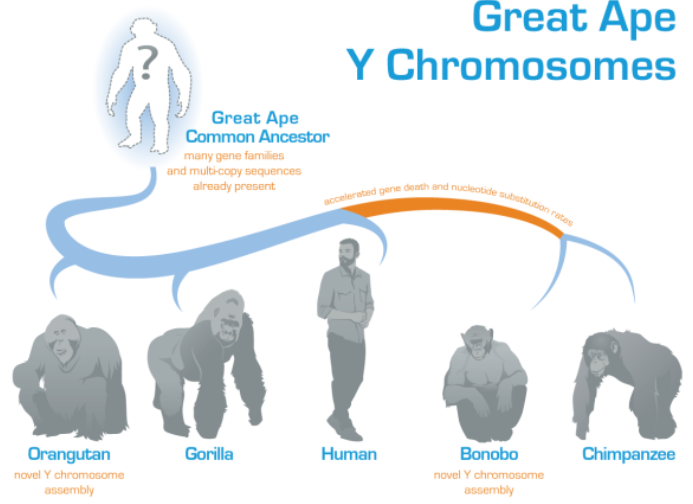Study Reveals Rapid Evolution of Y Chromosome in Apes
A major study that was recently released in the journal Nature shows how quickly the Y chromosome has changed in primates compared to humans. Scientists discovered that only 14–27% of Y chromosome regions in different ape species are similar to those in humans. This shows that humans and other ape species have evolved very differently. X chromosomes, on the other hand, are very different. They are over 90% similar across species, which means they have stayed mostly the same over time.
Study Dynamics: Sequencing Ape Sex Chromosomes
To learn more about how sex chromosomes have changed over time, scientists sequenced the genomes of six different types of apes. These apes included bonobos, chimps, gorillas, and two species of orangutans, as well as the less well-known siamang gibbons. For the first time, this thorough study used full sequencing similar to what is already available for human sex chromosomes. This made it possible to look into structural differences and evolutionary paths in more detail.
Evolutionary Insights: Comparisons and Contrasts
The times when different ape species and human lineages split apart are very different. For example, the Bornean and Sumatran orangutans split apart about 1 million years ago, while humans and their ancestors with these apes split apart up to 20 million years ago. The Y chromosome is thought to have a higher change rate because it is so important for making sperm, which requires DNA to be copied many times. On the other hand, the X chromosome has been stable over time, which suggests that the sex chromosomes are under different evolutionary stresses.
Genomic Features: Impact of Repetitive Elements
About 71–85% of the Y chromosome and 62–66% of the X chromosome are made up of repeating parts, such as palindromes. These palindromic sequences, which read the same forwards and backward, hold multiple copies of important genes. They may provide a way to protect genetic information from damage, which is especially important for the Y chromosome, which doesn’t have a homologous match when cells divide.
About Y chromosome evolution
- Size and Composition of the Y Chromosome: The Y chromosome, crucial for male development, is significantly smaller than the X chromosome, containing about 50 million base pairs compared to the X chromosome’s 150 million base pairs.
- Evolutionary Changes and Genetic Stability: Over evolutionary time, the Y chromosome has lost 90% of the genes it once shared with the X chromosome due to genetic degradation. Despite this, recent studies show that the Y chromosome has developed mechanisms to repair its genes through internal palindromic sequences, enabling self-recombination. Research indicates that the Y chromosome has stabilized over the last 25 million years, contradicting earlier beliefs that it might disappear.
- Evolutionary Variations Across Species: In some species, such as the Japanese spiny rat and mole voles, the Y chromosome has been lost entirely, with sex determination shifting to other mechanisms. This highlights the diverse evolutionary outcomes in sex chromosome development across different species.
Month: Current Affairs - June, 2024
Category: Science & Technology Current Affairs







